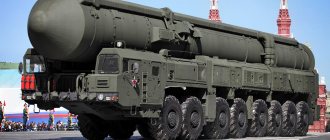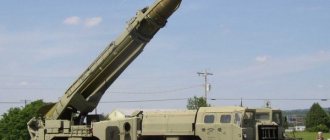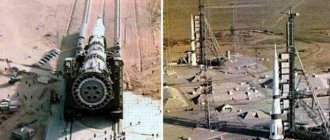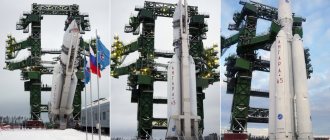Today, one of the newest achievements of domestic “missile scientists” is the RS-28 intercontinental ballistic missile, which also has a name - “Sarmat”. The ICBM has not yet been put into service, although this is planned for 2019-2021, but it has already managed to take part in the war. True, not in the nuclear one, but in the informational one.
Only the approximate technical characteristics of the Sarmat missile were officially announced, but reports have already appeared in the press about how perfect the missile is. Let's take a closer look.
History of creation
The silo-based intercontinental missiles R-36M, which received the respectful nickname “Satan” in NATO, have long remained the basis of Russian strategic forces. However, these weapons, the first samples of which went into service in the mid-70s, have become outdated. "Satan" still has truly "satanic" power, but is vulnerable to modern missile defenses. And the possibilities for further modernization are hampered by the fact that some of the R-36 developers remained on the territory of Ukraine.
As a result, the government decided to build a new missile equipped with anti-missile defense systems and capable of carrying non-nuclear warheads (kinetic action). Difficulties arose when choosing an engine. In rocket science, supporters were found for both solid-fuel engines and liquid-fuel engines. The first stated that solid fuel engines, due to the reduced throw mass, make it possible to build a light rocket suitable for launching from mobile installations.
The second objected - a solid-fuel ICBM, due to its accelerated acceleration, is less vulnerable in the acceleration section, while a “liquid” one can carry more active protection means and is therefore better protected precisely in the final section. This difficulty was resolved by issuing technical specifications for the design of two types of ICBMs at once. The R-36M was to be replaced by the RS-28 Sarmat missile.
The project is being implemented by the State Rocket Center named after Academician Makeev.
In the summer of 2016, the GRTs successfully completed tests of the RS-99 engines, and at the end of 2022, it conducted throw tests of a rocket prototype.
There is even less information about the progress of design work and testing of the Yu-71 Avangard warheads. Only in 2016, local residents filmed the trace left in the atmosphere by the maneuvering block. One way or another, the RS-28 should be put into service as early as 2022, and by 2025, as promised, it will completely replace the R-36M complex.
Tests of the RS-28 missile
Unfortunately, the collapse of the USSR, accompanied by a break in previous production and technological ties, had an extremely negative impact on the state of Russian industry, including the defense industry. This is why the implementation of many promising projects is being delayed. In particular, the originally planned dates for the first tests of Sarmat were disrupted. The trial launch was supposed to be carried out back in 2016, but this did not happen.
Only in the last days of the next year, 2022, was it possible to complete the so-called throw test. The essence of this test is to practice the “mortar launch”. The RS-28 Sarmat itself is not used; instead, a weight and size mock-up is placed in the silo, which is then thrown to a height of approximately 30 meters using a powder pressure accumulator.
The photographer captured the throwing test of the Sarmat complex, which supposedly took place on March 28, 2022
A total of three such tests were carried out:
- December 25, 2022. According to official reports, the “throw” was successful, all systems worked as normal;
- March 28 or 29, 2022. This time, the Ministry of Defense published a video of the launch, which clearly shows that not only the missile was removed from the silo, but also the launch of the first or second stage engines;
- In the second half of May 2022. After this launch, there was no further information about further “throws”, and then it was announced that this stage of testing had been completed.
Flight tests of the RS-28 were supposed to be carried out in 2022, but so far not a single launch has been carried out. Nevertheless, back in April, President Putin announced that the Sarmat tests were close to completion. After this, already in July, Roscosmos General Director Rogozin noted that it is planned to proceed to the final tests of the RS-28 only at the end of the future, 2022. In fact, this means that it will not be possible to replace “Satan” in 2022.
It should be, which were originally created as part of the Sarmat project, have been tested quite successfully since at least 2016. One of the test launches of the hypersonic vehicle, initially known under the designation Yu-71, was witnessed by many residents of the northern cities of Russia - the glider left an unusual fiery trail in the sky. The Avangards were launched using the intercontinental UR-100N UTTH, known in the West under the designation Stiletto.
RS-28 (or its weight and size mockup) before the first stage of throw tests
Guaranteed answer or first strike
Today, the very presence and quantity of charges plays a secondary role. Now the urgent task is either to be able to attack with impunity, or to ensure retaliation against the aggressor country. If the deployment of an American-made global missile defense system is intended to fulfill an offensive doctrine, then the development of retaliatory strike weapons is the main and priority direction in the development of Russia’s strategic forces.
Today, the basis of the Strategic Missile Forces are the carriers of “Voevoda” (they are known as “Satan”). They cannot be intercepted by any anti-missile systems. These ICBMs were produced back in Soviet times in Dnepropetrovsk, which became Ukrainian after the collapse of the USSR.
For all their advantages, the complexes fire like any military equipment. Not long ago, military analysts assumed that their service life would continue until 2022, but the current political situation, associated with specific maintenance issues, dictates a reduction in the time remaining until they are tested. But the task of adopting the modern strategic carrier “Sarmat” has become even more urgent. In 2018, the missile should replace the Voyevoda missiles currently in service in the silos.
Reliable guarantor
At an extended meeting of the Board of the Ministry of Defense in December 2022, the Supreme Commander-in-Chief of the Russian Armed Forces, Vladimir Putin, setting the tasks of the army and navy for the next period, said: “Of course, the decisive place is occupied by the tasks of ensuring the defense capability of Russia. No matter how events develop, the reliable, guaranteed protection of our Motherland from any potential military threats must remain unchanged.”
The first regiment is preparing for rearmament
The commander of the Strategic Missile Forces, Colonel General Sergei Karakaev, in an interview with the Krasnaya Zvezda newspaper, said that the Uzhur Red Banner missile division stationed in the Krasnoyarsk Territory will soon be re-equipped with the latest RS-28 Sarmat intercontinental ballistic missile.
“Currently, industrial enterprises continue to prepare for state flight tests of the Sarmat,” noted the commander of the Strategic Missile Forces. “Today, to ensure the rearmament of the first formation on this complex, work has begun to prepare the lead missile regiment for rearmament.”
The intercontinental formidable “cavalry” of the Sarmatian missiles is the guarantor of the peaceful life of our people and the sovereignty of the state for decades to come.
Balance of power
At the moment, the nuclear weapons of all countries are distributed as follows: approximately 45% of all special ammunition belongs to the United States and the Russian Federation. The number of charges is known and, according to the START-3 treaty, is approximately 1,550 sea- and land-based, plus 700 for aircraft. In terms of the number of speakers, the picture is somewhat different. The Americans have more of them (794 versus 528 Russians). This does not indicate any advantages of the potential enemy, but indicates that the United States has more monoblock systems.
90% of all atomic (hydrogen, neutron) charges are in service with the Russian and American armies. The remaining 10% belongs to Britain, China, France and other countries of the “nuclear club”. It is difficult to assess which state will take which side in the event of a global conflict. It is possible that many of them (non-NATO members) will prefer neutrality.
Design
The RS-28 Sarmat intercontinental ballistic missile is designed for deployment in silo installations. In this case, it is proposed not to build new mines, but to use already built ones. Little is known for certain about the structure of the rocket. For example, data on the number of stages was not disclosed, and conclusions were drawn based on the analysis of official images of the rocket. So far, it is believed that the Sarmat has 3 stages, which is not very typical for an ICBM.
The RS-99 engines are modernized RD-624 engines used on the Satan.
The use of motors that have long been mastered in production and operation made it possible to reduce the development time of the rocket. RS-99 accelerate the Sarmat to a speed slightly lower than that required to launch the thrown mass into orbit.
Thanks to this, the RS-28 approaches the selected target along any trajectory, which will require the potential enemy to deploy missile defense systems based on the “all-round defense” principle. On the other hand, such an ICBM, without significant modifications, is capable of launching not only warheads into orbit, and after being removed from service, civilian satellites will be sent into space using the RS-28.
The Sarmat's warhead should consist of several (according to some sources, more than 10) hypersonic guided units Yu-71 Avnagard.
The characteristics of these units have not been officially reported; it is only known that they have their own engines and control systems, and the Yu-71 warhead contains multiple warheads.
Protection against anti-missile missiles is provided both by the high speed and maneuverability of the Avangard, and by the constant maneuvering of the Sarmat warhead, which throws out warheads along with decoys. The Yu-71 warheads may not be nuclear - hypersonic speed allows them to hit targets using kinetic energy.
But active protection systems are not limited to those built directly into the missile. Since launch silos cannot be moved, and their location is usually known, the launch site is covered by the Mozyr complex. Along the path of the approaching warhead, the Mozyr creates literally a continuous cloud of destructive elements.
RS-28 "Sarmat". Technical features and policy implications
The adoption of a new missile system with the RS-28 Sarmat intercontinental ballistic missile is planned for 2022. At the moment, the new weapon is undergoing a test cycle, and the bulk of the data on it remains secret. However, official sources have already managed to reveal some of the information about the project, thanks to which the main features and capabilities of the promising rocket have become known. The available data makes it possible to understand why the Sarmat ICBM poses a particular danger to a potential enemy.
Over the past few years, the command of the strategic missile forces, as well as the military and political leadership of the country, have repeatedly raised the topic of the Sarmat project and announced various information about it. As a result, it became known that in 2022, a new complex with a heavy-class missile, distinguished by the highest characteristics, will enter service with the Strategic Missile Forces. Such weapons are intended to replace the old R-36M Voevoda ICBMs and should use the same launchers.
Global weapons
It is known that the new RS-28 missile features an improved propulsion system, giving it the highest characteristics. In the past, the positive qualities of the Sarmat, provided by new efficient engines, have been repeatedly noted. It is the engines that make it possible to increase combat stability and combat effectiveness.
Due to the greater engine thrust, the RS-28 product differs from previous domestically produced liquid-propellant ICBMs in its reduced duration of the active flight phase. This fact in a certain way complicates the operation of enemy missile defense systems that attack a target during acceleration, when it is most noticeable and vulnerable. In addition, this leads to the fact that during acceleration and entry into the trajectory, the Sarmat remains in a safe zone, inaccessible to enemy missile defense.
New engines (possibly in combination with certain combat equipment options) give the missile increased range characteristics. For example, back in 2014, Deputy Minister of Defense Yuri Borisov said that the new missile system has virtually no range restrictions. Sarmat warheads will be able to fly to their targets through the North or South Pole. This information was later confirmed by President Vladimir Putin. According to him, in terms of firing range, the new RS-28 ICBM is superior to the existing R-36M. However, both in the past and now, accurate data on the flight range are missing.
For some time now, the definition of “global weapon” has been used in relation to Sarmat. Indeed, the new propulsion system, in combination with certain variants of combat equipment, significantly increases the range of the missile system. The area of responsibility of Russian missiles includes not only the territory of expected potential adversaries, but also other areas of the globe. The practical value of such weapons is obvious.
Accurate strike
During his sensational address to the Federal Assembly last year, V. Putin said that the Sarmat would be able to carry a wide range of high-power nuclear weapons. In terms of the number and power of warheads, it will surpass the Voevoda. It also provides the possibility of using advanced hypersonic glide warheads - fundamentally new combat equipment with unique characteristics and capabilities.
From the president’s statements it follows that in the version of the carrier of a traditional multiple warhead with individual targeting units, the RS-28 will be able to carry at least 10 warheads. The power of each warhead is at least 800 kt. However, it is not yet entirely clear how exactly the Sarmat will surpass the Voevoda in the number and power of warheads and the composition of MIRVs. Along with the warheads, the warhead must contain decoys and other means of overcoming missile defense. The use of modern systems that provide a breakthrough through existing and future defense systems is announced.
Of particular interest is the version of the RS-28 complex with the Avangard hypersonic maneuvering warhead. For now, such products are used with UR-100N UTTH missiles, but in the future they will be transferred to modern Sarmatians. According to known data, the Avangard product is a hypersonic glider with its own warhead, launched using an ICBM. Previously, domestic missile systems were not equipped with such products.
According to recent statements, in flight the Avangard glider can reach speeds of up to M=27. It carries a special warhead and is capable of delivering it to intercontinental ranges. A gliding flight with the ability to perform maneuvers makes effective interception impossible using existing air defense and missile defense systems. At the same time, increased accuracy of hitting targets is ensured.
Apparently, in the future, Sarmat ICBMs with different variants of combat equipment will enter combat duty. However, the exact composition of the warheads and the proportions of different products in the overall group remain unknown, and are unlikely to be revealed in the foreseeable future.
Safe duty
From open data it follows that the RS-28 Sarmat ICBM is a milestone development of its kind. Obviously, missiles with enhanced combat characteristics become a priority target for a first strike by a potential enemy. Such risks are taken into account when developing new Russian weapons. As far as we know, in parallel with Sarmat, new means for operating and protecting missiles are being created.
In the future, new types of missiles will be placed in existing silo launchers, freed from obsolete weapons. Such structures themselves have a high class of protection against direct impact, and in addition, they must be equipped with additional means. In 2013, work was resumed on the topic of active protection systems for silo launchers of missile systems. In the past, such a system has confirmed its capabilities in practice, and in the future, serial models of this kind will have to provide protection for Sarmatovs on duty.
If all current plans are implemented, the silo launcher of the Sarmat complex will become an extremely difficult target for the enemy’s first strike, capable of maintaining functionality with a high probability and providing a retaliatory attack. If an incoming ICBM warhead or other enemy weapon is detected, the KAZ silo will have to shoot it down at a safe distance. If the ammunition can pass through the defense systems, the missile will remain intact thanks to the robust launcher. It should be noted that the methods of passive protection of silos and ICBMs were developed quite a long time ago, while active protection systems are new.
Threat from the future
The RS-28 Sarmat product is a serious threat to a potential enemy, but all the risks associated with it still remain problems of the future. The first missiles of the new type will go on duty in 2022, and a full replacement of the outdated R-36M will take place only a few years after that. Thus, in the coming years, a potential enemy will be deterred mainly by existing ICBMs.
However, the moment of putting Sarmat into service is approaching, and the industry is doing everything necessary for this. In a new message to the Federal Assembly dated February 20, V. Putin mentioned the continuation of testing of the RS-28 product, but did not go into details. On the same day, the Zvezda TV channel published some data on the current successes of the project.
Last year, the stage of throwing tests of the new rocket was successfully completed. During these works, fifty design and testing tasks were completed. It was possible to confirm the correctness of the design solutions used in the project. Bench tests of rocket engines were also carried out. Practical work on the breeding stage is underway.
At the same time, industry is preparing for mass production of missiles and Ministry of Defense facilities for new tests. Thus, at the Plesetsk test site, the infrastructure for flight and state tests of Sarmat is being completed. The enterprises involved in the project are updating their production capacities, which will subsequently allow them to participate in the assembly of an experimental batch of missiles, and then master the series.
This year, the first test launch of a new missile should take place at the Plesetsk test site, followed by a full flight and destruction of a conditional target at the Kamchatka Kura test site. Flight tests should be completed in 2020-21, after which the missile system will be put into service. Next, full-fledged serial production will begin with the placement of missiles on duty.
It is in 2022 that the RS-28 ICBMs will begin to realize their potential and become a new military-political tool. At first they will solve common problems together with the outdated R-36M, but then they will completely displace them and completely occupy the corresponding niche. Most likely, updating the arsenals of heavy ICBMs will not lead to a noticeable change in quantitative indicators, and in the future there will be approximately the same number of Sarmatovs on duty as Voyevod currently costs. However, we should expect a noticeable increase in quality, ensured by increased characteristics and the acquisition of new capabilities.
Thus, by the middle of the next decade, Russia will have a new promising instrument of strategic deterrence with special capabilities. The threat of retaliatory use of RS-28 Sarmat missiles, capable of breaking through any existing missile defense and delivering precise strikes using one or another combat equipment, should have a sobering effect on overly ardent representatives of the potential enemy’s command.
Based on materials from the sites: https://mil.ru/ https://kremlin.ru/ https://tvzvezda.ru/ https://tass.ru/ https://ria.ru/ https://bmpd. livejournal.com/
Technical characteristics of the Sarmat missile
As you might guess, comprehensive information about the newest Russian ICBM has not yet been published.
The available information can be summarized in the following table:
| Range of flight | 18,000 km |
| Starting weight | 208.1 tons |
| Case length | 36.3 meters |
| Rocket diameter | 3.02 meters |
| Throwing weight | More than 10 tons |
| Weight of fuel and oxidizer | 178 tons |
| Head type | Multiple independently targetable warheads or a set of hypersonic units |
| Number of warheads | 10-15, or 3-4 UBB "Avangard" |
| Single charge power | From 750 kilotons to 1 megaton (according to various sources) |
| Circular probable deviation | Tens of meters (presumably) |
Previously published reports that the starting weight of the Sarmat would be half that of the Voevoda were not confirmed. True, there is a version according to which the rocket is built in two versions - “heavy” and “light”.
Until the first RS-28s are put on combat duty in the Strategic Missile Forces, all information about this weapon cannot be considered 100% reliable. Of course, the production of rockets with liquid engines was well mastered back in the days of the USSR, however, the constant failure to meet deadlines and failure to fulfill promises inevitably sets one in a skeptical mood. One way or another, today it is already clear that replacing the aging “Voevod” with “Sarmat”, even if it does not have the full capabilities advertised today, will significantly strengthen Russia’s defense capability, thereby supporting its state sovereignty.
The magic of a name
The liberator of the Balkans and conqueror of Central Asia, Russian general Mikhail Dmitrievich Skobelev, taught: enemies must be beaten not only by the back of the neck, but also by the imagination. Russian gunsmith designers remember this testament. “Sarmat” is a historically formidable, frightening name.
Exiled by Emperor Augustus to the eastern outskirts of the Roman Empire, the great poet Ovid described with anguish and fear the raid on the city of Tomy (present-day Romanian Constanta) by a horde of Sarmatian nomads in 8 AD. In the famous “Sorrowful Elegies” we read: “an enemy, strong with a horse and a far-flying arrow,” “enemies swoop in in a flock of predators.” Ovid repeatedly mentions the poisonous hooked arrows of the Sarmatians, from which there is no salvation. Pliny the Elder also writes that steppe nomads wet the tips of their arrows with poison.
The “arrowheads” of the Sarmat missile—warheads—will be able to deliver nuclear “poison” to targets anywhere in the world. New Russian intercontinental ballistic missiles (ICBMs) are capable of flying through the North or South Pole.
Russia's nuclear triad: always on alert
“The order of the President of the Russian Federation to equip strategic nuclear forces with fundamentally new strike systems is being fulfilled.
The level of modernity in the Strategic Missile Forces (RVSN) exceeded 76%, and in the nuclear triad it is 82%. The first missile regiment, armed with the Avangard missile system with hypersonic gliding winged units, took up combat duty. Three more missile regiments have been re-equipped with the Yars mobile ground-based missile system. The deployment of Peresvet laser systems has been completed. Since December 1, 2022, they have been on combat duty in the position areas of five missile divisions of the Strategic Missile Forces. The strategic aviation nuclear forces were replenished with five modernized missile carriers. Tests of the lead nuclear submarine of the Borey-A project, Prince Vladimir, have been successfully completed.
Russian Defense Minister, Army General Sergei Shoigu. From a report at an extended meeting of the Board of the Ministry of Defense of the Russian Federation. Moscow, December 24, 2022.
Tests
The production of a new technical sample always involves a serious risk, but if successful, it is completely justified.
Work on this project began in 2009. Design Bureau, after 2 years of research, has finally started testing.
In the early fall of 2011, the vicinity of the Kapustin YaR cosmodrome was damaged by a powerful explosion. The Sarmat rocket, on which serious hopes were pinned, crashed to the ground a few minutes after launch. All further launches, unfortunately, also turned out to be unsuccessful.
Only a year later there was a successful launch. This time, experts took into account basic ballistics indicators. Tests have shown that the Sarmat liquid-propellant rocket is capable of covering more than 11,000 km, while carrying a fighting compartment weighing 4,350 kg. In the spring of 2014, Yu. Borisov (Deputy Minister of Defense) announced that all work on the development of a new strategic complex was proceeding smoothly, according to a clearly planned schedule.
He believes that the new Sarmat missile will have no restrictions in terms of combat use and will be able to hit targets along trajectories that pass through both poles of the planets. This is critical because NATO rugged systems are not designed for this kind of versatility.
The purpose of the rocket
The main goal pursued by the designers who created the RS-28 was to obtain a powerful strategic weapon capable of delivering a retaliatory or retaliatory nuclear strike on the territory of any potential aggressor. From this point of view, the purpose of “Sarmat” and “Voevoda” is the same. However, the new intercontinental ballistic missile can be used in other ways.
The following “alternative” uses of the RS-28 are allowed:
- "Instant global impact." The kinetic energy of hypersonic guided units is so great that they can be used to destroy any key targets on enemy territory without the use of nuclear “stuffing”;
- Destruction of aircraft carrier groups. Increasing the hit accuracy and the ability to reorient the UBB during the flight makes it possible to target them at large surface ships. Airborne air defense systems will not be able to repel such a strike;
- Launching satellites into low-Earth orbit. It is assumed that at the end of its service life the Sarmatians will be used precisely for this purpose. Both military and civilian vehicles can be launched into space.
It should be noted that the Chinese press published articles whose authors regarded the RS-28 as a first-strike weapon, not a retaliatory strike weapon. Theoretically, such use is not excluded by the current military doctrine. We can only hope that no political aggravation will force the Russian leadership to resort to such a desperate step.
In fact, the new Sarmat missile will become an incredible threat to all opponents of the Russian Federation already in 2022. But for now, all the risks are only “in the air”, because the rocket has not yet returned to duty. The complete replacement of all missiles with these RS-28s will obviously occur gradually, because this requires a lot of effort and resources. I would like to say that for now the opponents can only resist active complexes, but think about the coming threat.
Already in 2022, the rocket underwent throw tests, in which many improvements and modifications were introduced. There were also tests for the engine, which were successful. Also, Russian production is preparing for the assembly line production of Sarmatovs, and the industries involved are constantly strengthening their mechanisms to create such weapons.
Political weapons
The appearance of Sarmat in the arsenal of our Strategic Missile Forces will allow Russia to maintain strategic parity with the United States for many years. Although the Americans have already begun to have verbal jitters: the Russians, they say, are overtaking us and surpassing us.
On February 13 of this year, speaking in Washington at a conference on nuclear deterrence, Pentagon deputy chief of acquisition and sustainment Alan Shaffer said that Russia, as well as China, “has an arsenal of intercontinental ballistic missiles sufficient to solve deterrence problems.” New strategic weapons among the United States' geopolitical competitors, according to Schaffer, "are a pressure threat to our triad, and that's why modernizing the triad is so important."
© deterrencesummit.com
Deputy head of the Pentagon for procurement and technical support Alan Shaffer.
This, of course, is where Mr. Shaffer should have started... If there is no reason to justify one’s own rearmament, one must blame the Russians for everything. The background to this and many other similar statements is simple: the end of START III, the Russian-American treaty on strategic offensive weapons, is approaching. The term expires in February 2022, and Washington will not decide whether they need to extend the agreement, which remains the only one between Russia and the United States in the field of arms limitation.
Russian President Vladimir Putin has repeatedly stated his readiness to extend START-3. There was still no clear answer from the American side. The United States has two “special” conditions: China must be included in the agreement and new Russian superweapons must be “tied” to it - hypersonic systems. According to the logic of the Americans who love to pull chestnuts out of the fire with the wrong hands, it is Russia that must persuade the PRC to participate in the new treaty. Russian Foreign Minister Sergei Lavrov called this US demand a “winding up” of the prospects for extending New START.
“The PRC has officially stated many times that it will not participate in this kind of negotiations, explaining that the structure of China’s nuclear forces is radically different from the nuclear forces of the United States and the Russian Federation. Why on earth and how can the Chinese be forced?” - said Lavrov. As for our weapons, in this matter Russia is ready to discuss the possibility of introducing new types of weapons into the Treaty on the Reduction of Strategic Offensive Arms. “The Americans are interested in our new weapons,” said Sergei Lavrov. “We have already mentioned that our military is ready to consider some of these new weapons - at least Avangard and Sarmat - in the context of the treaty criteria.” But at the same time, as the head of the Russian Foreign Ministry pointed out, the United States and Western countries should do the same and refuse to create similar weapons.
Apparently, the US does not want to agree with this. It is not for nothing that high Pentagon official Alan Shaffer announced the need to modernize the US nuclear triad.
However, while they are threatening and planning overseas, here in Russia we are already completing the testing of Sarmat, a significant instrument of strategic deterrence. The threat of retaliatory use of intercontinental ballistic missiles of the RS-28 complex, capable of breaking through any existing missile defense and delivering precise strikes with nuclear warheads, the further, the more sobering it will have on both generals and politicians of any states that are potential opponents of Russia.
Read in Zhongguo Junwang (China)
“Thanks to their size and powerful characteristics, the outstanding missiles of our time, heavy ICBMs of the R-36M class, present a “greatest shock” to the strategic enemy. They have been a means of intimidation for quite a long time. NATO calls them “Satan,” which speaks of the fear and respect these missiles inspire.
However, due to the fact that the service life of the R-36M missiles will soon come to an end, and the air defense and missile defense forces... continue to be strengthened, the Russian side has decided to develop a new intercontinental ballistic missile capable of bypassing all existing and future missile defense systems..." .
In terms of its power, the Sarmat is not only not inferior, but also superior to its predecessors - intercontinental ballistic missiles of the R-36M type. According to experts, one Sarmat missile is capable of destroying an entire city or a small or medium-sized country.











